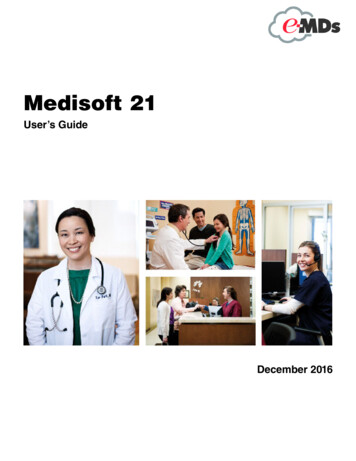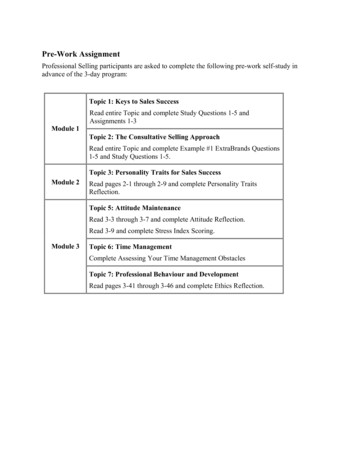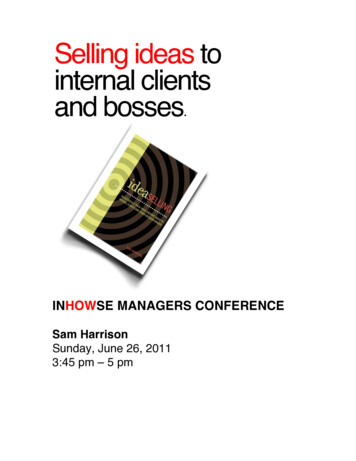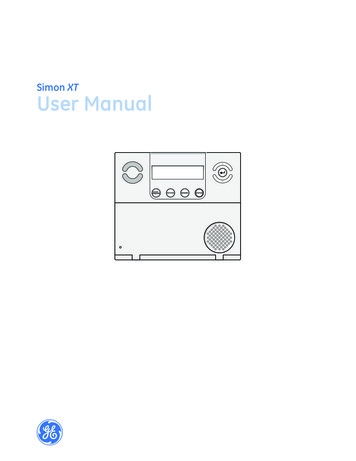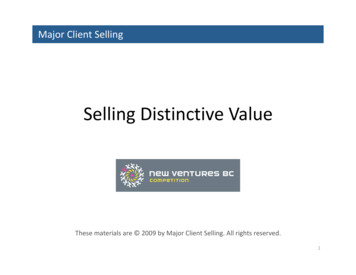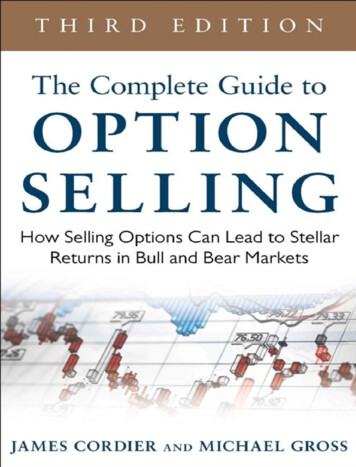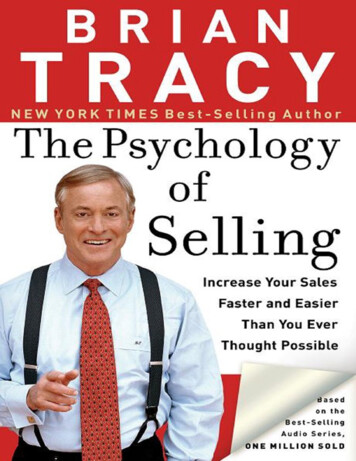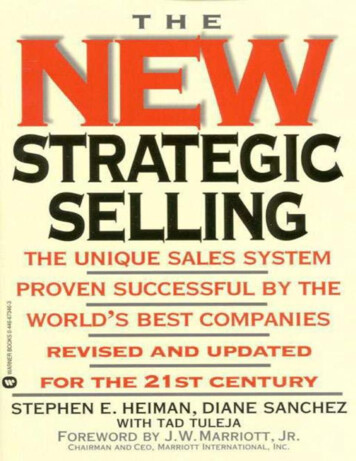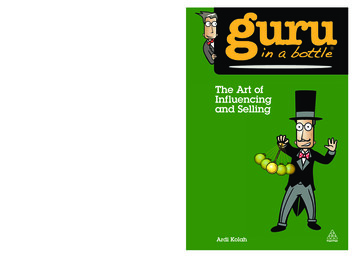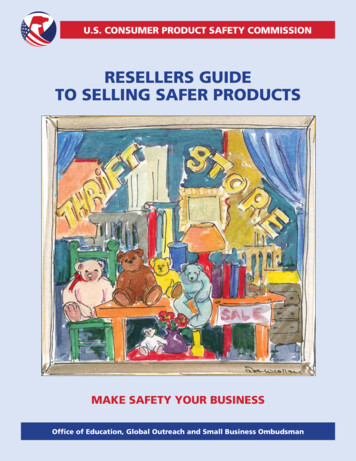
Transcription
U.S. CONSUMER PRODUCT SAFETY COMMISSIONRESELLERS GUIDETO SELLING SAFER PRODUCTSMAKE SAFETY YOUR BUSINESSOffice of Education, Global Outreach and Small Business Ombudsman
Cover image from The Thrift Store Bears: Poems used by express permission of the illustrator, Patricia Woolley, and David Evans,in honor of his late wife and author, Olive Evans. Ms. Evans collected stuffed bears from thrift stores and wrote the poemsto keep her spirits high during her struggle with breast cancer.Jim Furmston scored the accompanying music to The Thrift Store Bears: Poems.
TABLE OF CONTENTSThe electronic version of this document (www.cpsc.gov/resale) provides access to additional helpful information available by clicking onthe hyperlinks — the letters, words, phrases, and web addresses shown in dark blue provided throughout the document.Introduction. . . . . . . . . . . . . . . . . . . . . . . . . . . . . . . . . . . . . . . . . . . . . . . . . . . . . . . . . . . . . . . . . . . . . . . . . . . 2The Basics. . . . . . . . . . . . . . . . . . . . . . . . . . . . . . . . . . . . . . . . . . . . . . . . . . . . . . . . . . . . . . . . . . . . . . . . . . . . . 3You are not required to test your products. . . . . . . . . . . . . . . . . . . . . . . . . . . . . . . . . . . . . . . . . . . . . . . . 3What you cannot sell. . . . . . . . . . . . . . . . . . . . . . . . . . . . . . . . . . . . . . . . . . . . . . . . . . . . . . . . . . . . . . . . . . 3CPSC Can Help You. . . . . . . . . . . . . . . . . . . . . . . . . . . . . . . . . . . . . . . . . . . . . . . . . . . . . . . . . . . . . . . . . . . . . 4CPSC’s Response to Violations. . . . . . . . . . . . . . . . . . . . . . . . . . . . . . . . . . . . . . . . . . . . . . . . . . . . . . . . . . . 5Product Guides . . . . . . . . . . . . . . . . . . . . . . . . . . . . . . . . . . . . . . . . . . . . . . . . . . . . . . . . . . . . . . . . . . . . . . . . 6Bath Seats. . . . . . . . . . . . . . . . . . . . . . . . . . . . . . . . . . . . . . . . . . . . . . . . . . . . . . . . . . . . . . . . . . . . . . . . . . . 7Bean Bag Chairs. . . . . . . . . . . . . . . . . . . . . . . . . . . . . . . . . . . . . . . . . . . . . . . . . . . . . . . . . . . . . . . . . . . . . . 8Bunk Beds for Children . . . . . . . . . . . . . . . . . . . . . . . . . . . . . . . . . . . . . . . . . . . . . . . . . . . . . . . . . . . . . . . . 9Car Seats/Carriers Combination. . . . . . . . . . . . . . . . . . . . . . . . . . . . . . . . . . . . . . . . . . . . . . . . . . . . . . . . . 10Cribs . . . . . . . . . . . . . . . . . . . . . . . . . . . . . . . . . . . . . . . . . . . . . . . . . . . . . . . . . . . . . . . . . . . . . . . . . . . . . . 11Drawstrings on Children’s Clothing . . . . . . . . . . . . . . . . . . . . . . . . . . . . . . . . . . . . . . . . . . . . . . . . . . . . . 12Hair Dryers . . . . . . . . . . . . . . . . . . . . . . . . . . . . . . . . . . . . . . . . . . . . . . . . . . . . . . . . . . . . . . . . . . . . . . . . . 13Halogen Floor Lamps. . . . . . . . . . . . . . . . . . . . . . . . . . . . . . . . . . . . . . . . . . . . . . . . . . . . . . . . . . . . . . . . . 14Lead in Children’s Products. . . . . . . . . . . . . . . . . . . . . . . . . . . . . . . . . . . . . . . . . . . . . . . . . . . . . . . . . . . . 15Lead in Children’s Products Summary. . . . . . . . . . . . . . . . . . . . . . . . . . . . . . . . . . . . . . . . . . . . . . . . . . . . 16Mattresses. . . . . . . . . . . . . . . . . . . . . . . . . . . . . . . . . . . . . . . . . . . . . . . . . . . . . . . . . . . . . . . . . . . . . . . . . . 17Phthalates. . . . . . . . . . . . . . . . . . . . . . . . . . . . . . . . . . . . . . . . . . . . . . . . . . . . . . . . . . . . . . . . . . . . . . . . . . 18Play Yards, Mesh-Sided . . . . . . . . . . . . . . . . . . . . . . . . . . . . . . . . . . . . . . . . . . . . . . . . . . . . . . . . . . . . . . . 19Small Parts . . . . . . . . . . . . . . . . . . . . . . . . . . . . . . . . . . . . . . . . . . . . . . . . . . . . . . . . . . . . . . . . . . . . . . . . . 20Toy Chests. . . . . . . . . . . . . . . . . . . . . . . . . . . . . . . . . . . . . . . . . . . . . . . . . . . . . . . . . . . . . . . . . . . . . . . . . . 21Toys with Magnets. . . . . . . . . . . . . . . . . . . . . . . . . . . . . . . . . . . . . . . . . . . . . . . . . . . . . . . . . . . . . . . . . . . 22Walkers (Baby). . . . . . . . . . . . . . . . . . . . . . . . . . . . . . . . . . . . . . . . . . . . . . . . . . . . . . . . . . . . . . . . . . . . . . 23CPSC Resources. . . . . . . . . . . . . . . . . . . . . . . . . . . . . . . . . . . . . . . . . . . . . . . . . . . . . . . . . . . . . . . . . . . . . . . 24
INTRODUCTIONThe U.S. Consumer Product Safety Commission (CPSC) created this Guide for Resale Storesand Product Resellers to help you identify the types of products that are affected andto understand how to comply with the law so that you can keep unsafe products out ofthe hands of consumers. Consumers who regularly buy used products may also find thisinformation helpful in avoiding products that could harm them or their family.On August 14, 2008, the President signed into law the Consumer Product SafetyImprovement Act of 2008 (CPSIA). The implementation of the CPSIA has resulted in dramaticchanges in the used product marketplace. For example: Selling recalled products is now unlawful. The law sets strict limits for lead in paint and for lead content. Most cribs manufactured before June 2011 may not be resold. New regulations (mandatory standards) are being put into practice for durable infantand toddler products, such as play yards, infant walkers, bath seats, bed rails fortoddlers, and more.In light of these new requirements for many consumer products, resellers should closelyexamine their products in inventory prior to resale to make sure that their products are safeand compliant with federal laws. This Guide will help you make sound business decisions toprotect yourself and your customers.Please make sure you visit our website at: www.cpsc.gov/resale — for updates on thisinformation and to sign up for the email list we created specifically for resale stores andproduct safety.www.cpsc.gov2
THE BASICSThe CPSC’s laws and regulations apply to anyone who sells or distributes consumer products.This includes thrift stores, consignment stores, charities, and individuals holding yard salesand flea markets.CPSC does not require you to test your products for safety.CPSC urges you to take a few extra steps when you sell your used products and to follow theadvice in this Guide to ensure that you are only selling safe products. And while you are notrequired to test your products for safety, resale stores, resellers (including those who sell onauction websites), and persons who give away used products for free cannot knowingly sellproducts that do not meet the requirements of the law. If a product is hazardous, or doesnot comply with standards, the product should be destroyed and not be sold or given awayto others.You can protect yourself and your customers by using the resources in this Guide and atwww.cpsc.gov/resale to screen for hazardous and other violative products. Ignorance of thelaw is not an excuse. But more importantly, as a person and as a business, you do not wantto sell products that have the potential to cause harm to anyone, especially a child.Examples: What you cannot sell or offer for sale: Children’s metal jewelry that does not comply with the federal limit on lead of 100parts per million; Products that have been recalled by the CPSC (unless theproducts have been repaired in accordance with the recall); Toys and other articles intended for use by childrenand any furniture with paint or other surface coatingscontaining lead over the specified amount; Products intended primarily for children age 12 or youngerwith lead content known to be over the specified amount; Most cribs manufactured before June 2011 may notbe resold; Durable infant and toddler products, such as play yards, infant walkers, bath seats,bed rails for toddlers, and others that are missing parts, appear wobbly or unstable,or contain known hazards described in this Handbook; and Other products that violate the CPSC’s safety standards, bans, rules, or regulations,or that otherwise present a substantial product hazard.www.cpsc.gov3
CPSC CAN HELP YOUThe CPSC would like to help you ensure that the products you sell are safe. You shouldperiodically check www.cpsc.gov/resale for updates to the information in this Guide. Inaddition, the CPSC has many tools available to help you stay informed about recalls andproduct safety. (On average, CPSC recalls between 300 – 500 products annually.)If you are in the business of reselling products, you are expected to know the laws, rules,and regulations that apply to your business, including whether a product you are selling hasbeen recalled for a safety issue. It is illegal to sell any recalled product. Search Recalls: SaferProducts.gov has a listing of CPSC recalls and consumer reportsof harm related to consumer products. Review the list of recalled products beforetaking a product into inventory or selling it. You can also receive information aboutCPSC recalls by subscribing to the CPSC’s recall email list. Keep Current: Subscribe to the CPSC’s email list for resale stores and productresellers, and keep current on information developed specifically for resale stores at:www.cpsc.gov/resale. When in doubt, throw it out! Products used in the nursery, especially cribs andbassinets, have caused deaths and have been the subject of numerous recalls ofmillions of units. Do not sell any broken or wobbly nursery furniture or durable infantproduct that is missing parts, even if it has not been recalled. A baby’s life coulddepend on it. The risk is too high. Contact: For questions about regulatory requirements, contact CPSC’sOffice of Education, Global Outreach, and Small Business Ombudsman:Email: Business@cpsc.gov; telephone (301) 504-7999; or contact the CPSC’s SmallBusiness Ombudsman at: www.cpsc.gov/smallbiz for additional information andguidance for small businesses. Contact: For questions about enforcement, contact CPSC’s Office of Compliance forinquiries regarding enforcement: Email: sect15@cpsc.gov; telephone: (301) 504-7520.www.cpsc.gov4
CPSC’S RESPONSE TO VIOLATIONSThe CPSC’s goal is to help you avoid future violations and protect your customers—not toput you out of business. If you learn that one of the products you sell violates the law orpresents a hazard, immediately inform the Commission.Under the law, it is illegal for retailers to sell or offer for sale a product in violation of theCPSIA or other CPSC laws. Our purpose is to ensure these products aren’t being sold, so westill need to hear from you if you discover you may have sold one of these products in thepast. The information you provide us will assist us in developing future outreach programstargeting resellers so these hazardous products won’t be sold. When informed of the sale ofsuch products, we will work with you to ensure the agency’s response is appropriate underthe circumstances.You can report a potentially defective or hazardous product at: www.SaferProducts.govor by phone at (800) 638-2772.THANK YOUThank you for working with the CPSC to ensure that the children’s products and otherconsumer products you sell are safe and comply with all applicable product safety rules.This publication was developed by the CPSC’s Office of Education, Global Outreach,and Small Business Ombudsman. Suggestions, feedback, and additional questions arewelcomed at: Business@cpsc.gov.www.cpsc.gov5
PRODUCT GUIDESThe following guides provide illustrations of safety concernswhen reselling products. Even if a product is not listed here,you should take similar care in reviewing each productand consider the potential hazards described in these guides.Additional product guides will be added over time and distributedat www.cpsc.gov/resale.www.cpsc.gov6
BABY BATH SEATSHAZARDS: Drowning, submersion.Infant bath seats are used in a sink or tub to provide back and front support tobathe a seated infant. They are marketed for use with infants between 5 and10 months of age.There are three primary hazards with baby bath seats that typically occur whenthe child is left unattended, even for a short period of time: the bath seat becomesunstable and tips the child over into the water; the child slips through the bath seatleg opening into the water; or the child attempts to climb out and falls into the water.CPSC staff is aware of 29 deaths associated with baby bath seats and similar productsduring 2006 – 2008.Does not meetmandatory standardsMandatoryStandardsThe mandatory standard for baby bath seats went into effect on December 6, 2010.Go to: 16 CFR Part 1215.RecallsCheck www.SaferProducts.gov for baby bath seat recalls. It is illegal to sell a recalledproduct.RESELLER RESPONSIBILITY: CPSC staff advises you to destroy bath seats that: w ere made prior to December 6, 2010 before the new safety standard went into effect. (See datecode stamp on the bottom of the product or contact the manufacturer.); a ttach directly to the tub floor with suction cups. (Suction cups may have contributed to somebath seat-related deaths because they failed to adhere to the tub surface, they separated fromthe bath seat, or they were missing); a re broken or damaged; or d o not have permanent warnings visible on the product. Warning labels are required by law tobe fixed to the bath seat to alert parents and caregivers that bath seats are not safety devicesand that infants should never be left unattended in a bath seat.OTHER RESOURCES: Business Guidance for Bath Seats (Infant)www.cpsc.gov7
BEAN BAG CHAIRSHAZARDS: Suffocation, choking.Bean bag chairs made with zippers and foam pellets have resulted in deaths, aswell as nonfatal incidents. Children have unzipped bean bag chairs, crawled inside,inhaled or ingested the foam pellets, and suffocated. Some have unzipped the chairs,then pulled out the foam pellets and played with them. The pellets clogged theirmouths and noses, and they suffocated. Other children choked on the pellets butsurvived. CPSC received reports of 5 deaths and 26 nonfatal incidents associated withbean bag chairs. Victims ranged in age from 14 months to 14 years. Since 1996, beanbag chairs have been manufactured with zippers that young children can’t open.The voluntary standard for bean bag chairs requires that chairs intended to be refilled must have a locking zipperthat opens only with a special tool. Chairs not intended to be refilled must have a permanently disabled zipper orno zipper. In addition, the requirements include permanent warning labels for bean bag chairs. The label wordingdiffers depending on whether the chairs can be refilled. Durability testing is intended to ensure that materials thatcould tear easily and allow pellets to escape and be inhaled are not used in manufacturing bean bag chairs.VoluntaryStandardsGo to: ASTM F1912-98 (reapproved 2009). Voluntary standards are industry technicalspecifications that are developed by industry, government, and consumer representatives.RecallsCheck www.SaferProducts.gov for bean bag chair recalls. It is illegal to sell a recalledproduct.RESELLER RESPONSIBILITY: CPSC staff advises you to destroy any bean bag chair that has: a zipper that can be opened by young children; stuffing or pellets coming out of the chair; and s eams that can come apart if they are pulled. The foam pellets could escape, posing a hazard to children.OTHER RESOURCES: Bean Bag Chair Recallswww.cpsc.gov8
BUNK BEDSHAZARDS: Strangulation, suffocation, hanging.A bunk bed is any sleep structure with at least one mattress foundation more than30 inches above the floor. A mattress foundation is the base or support on which youplace the mattress. Since 1990, more than 70 children have died by strangulation orsuffocation from entrapment in bunk beds. Most were 3 years old or younger. Somechildren strangled when their bodies, but not their heads, slid between a guardrailand the bed frame, leaving their bodies hanging. Some suffocated when they becametrapped in openings within the footboard or headboard end structures or between thebed and the wall. CPSC staff also is aware of incidents of hanging, where some childrenhanged from a top bunk when something they were wearing caught on a verticalprotrusion as they were climbing out of the bunk.MandatoryStandardsThe mandatory standard for bunk beds went into effect on June 19, 2000.Go to: 16 CFR Parts 1213, 1500, 1513 to review the regulations. (The voluntary standard isASTM F1427, Standard Safety Specification for Bunk Beds.)RecallsCheck www.SaferProducts.gov for bunk bed recalls. It is illegal to sell a recalled product.RESELLER RESPONSIBILITY: Check the assembled bunk bed, and only sell it if it has all of thefollowing safety features. Otherwise, destroy it.Guardrails on Both Sides of the Upper Bunk: One guardrail should run continuously from the headboard to the footboard. I f a guardrail is not continuous, there should be no openings greater than 15 inches between the endof the guardrail and either end structure (headboard or footboard). There should be no openings larger than 3 ½ inches within, or immediately below, the guardrail.End Structures: T he end structures in the upper bunk must not have openings larger than 3 ½ inches. The endstructures in the lower bunk should not have openings larger than 3 ½ inches, unless those openingsare 9 inches or greater.Other Requirements: ssemble and ensure that the bunk beds have all component parts, including all screws and hardware. AFor tubular metal bunk beds, there must be no breaks or cracks in the paint or metal around the weldsthat hold the side rail to the bed frame at all four corners of the upper and lower bunks. T here should be no vertical protrusions or projections, such as ladder stiles or corner posts, that extendmore than 3/16 inch above the top of any end structure, guardrail, or other part of the upper bunk. T here should be a warning label on the bed that describes the strangulation hazard from childrenbecoming entangled from items attached to or hanging from the upper bunk. T he mattress, if there is one, should match the size specified in the warning label on the bed.Specifically, the top of each guardrail should be at least 5 inches above the top of the mattress and thetop of each end structure (headboard and footboard) should be at least 5 inches above the top of themattress for at least half of the mattress length.OTHER RESOURCES: Business Guidance for Bunk Bedswww.cpsc.gov9
CAR SEATS/CARRIERS COMBINATIONHAZARDS: Skull fractures, concussions, cuts, scrapes, bruises.A combination infant car seat/carrier is a product that can serve as both a carseat and as a hand held infant carrier. This safety information summary addresseswhen an infant carrier is used outside of a vehicle. (The National Highway TrafficSafety Administration (NHTSA) provides advice about the safety of car seats used invehicles at NHTSA — Parents Central.)Most injuries and deaths associated with carrier seats outside of vehicles resultfrom falls when an adult carries the car seat with the baby inside. A number ofCPSC recalls were due to the handles or locks breaking, releasing and/or rotatingunexpectedly allowing an infant to fall to the ground or be ejected on their ownor when an adult carrying the seat falls down. These falls resulted in skull fractures,lacerations, broken bones, bruises, and scratches.In 2010, there were an estimated 16,900 carrier-related injuries (excluding motor vehicle incidents) treated inU.S. hospital emergency departments. Between 2006 and 2008, there were 35 deaths among children less than5 years old associated with infant carriers and car seat carriers.VoluntaryStandardsThe voluntary safety standard for hand held carriers for use outside of vehicles is found at:ASTM Voluntary Standard F2050. Voluntary standards are industry technical specificationsand are developed by industry, government, and consumer representatives.RecallsCheck www.SaferProducts.gov for CPSC infant carrier recalls and SaferCar.gov for NHSTAcar seat recalls. It is illegal to sell a recalled product.RESELLER RESPONSIBILITY: Contact the manufacturer — if you have a CPSC or NHTSA recalled car seat/carrier,it may be able to be repaired to make it safe. Otherwise, destroy it. Check with NHTSA to see if the expiration date on the infant carrier has passed.OTHER RESOURCES: CPSC Safety Information for Hand Held Infant Carriers; NHTSA Parents Central — Using aSecondhand Car Seatwww.cpsc.gov10
CRIBSHAZARDS: Suffocation, strangulation.NEW: On June 28, 2011, new and improved safety regulations went intoeffect for full- and non-full-size cribs. These new mandatory rules include theelimination of drop sides, and greater structural integrity and crib strength.Do not assume that all non-drop-side cribs (even those where the drop-sidehas been immobilized) comply with the standard. They do not. No cribsmay be manufactured, sold, or resold that do not meet these more stringentstandards.Definitions: A full-size crib is one that has interior dimensions of 28 5/8 inches wide, 52 3/8 inches long(within the range of 2 inches). A non-full-size crib can be either smaller or larger than these dimensions and include oversized,specialty, undersized, and portable cribs that have rigid sides.Between November 2007 and April 2010, CPSC had reports of 35 deaths in cribs due to structural problems,many of which were related to drop-side fatalities and/or gaps opened up by loose/missing screws, or otherhardware failures. Thirty-four of the 35 deaths were due to head/neck/body entrapments.MandatoryStandardsThe mandatory standard for full- and non-full-size cribs went into effect on June 28, 2011.Go to: 16 CFR Parts 1219, 1220.RecallsCheck www.SaferProducts.gov for crib recalls. It is illegal to sell a recalled product.RESELLER RESPONSIBILITY: D estroy any full- or non-full-size crib (with or without drop sides) manufactured before June 28, 2011unless you have written proof that the crib meets the standard above. (NOTE: Absolutely no drop sidecribs in the used marketplace — even if immobilized with new hardware — can meet the standard and,therefore, must be destroyed.) Each full-size and non-full-size crib must have a date stamp markedpermanently on the product. F or cribs manufactured after June 28, 2011, assemble and make sure that the cribs have all componentparts, including all screws and hardware and check for recalls. D o not accept cribs that do not comply with the federal standard.A non-full-size crib does not include products such as play yards, cradles, baby baskets, and bassinets withmesh/net/screen siding. These products may be subject to other regulations. See additional CPSC resellers’guidance on your product.OTHER RESOURCES: Crib Information Center; Business Guidance For Cribs (Full-Size) And Cribs (Non-Full-Size)www.cpsc.gov11
DRAWSTRINGS ON CHILDREN’S CLOTHINGHAZARDS: Strangulation.Drawstrings are non-retractable cords, ribbons, or tapes of any material to pull togetherparts of upper outerwear to provide for closure. The CPSC regulation defines “upperouterwear” as “clothing, such as jackets and sweatshirts, generally intended to be worn onthe exterior of other garments.”Young children can be seriously injured or killed if the upper outerwear they are wearingcatches and snags on other objects. CPSC staff is aware of 18 deaths and 38 nonfatalincidents associated with neck/hood drawstrings on children’s outerwear between January1985 and September 2009, involving children 18 months to 10 years of age. Of these,the most common incident scenarios involved drawstrings getting entangled onplayground slides. Typically, as a child descended the slide, the toggle or knot on thedrawstring got caught in a small space or gap at the top of the slide. Examples of catchpoints include: a protruding bolt or a tiny space between the guardrail and the slideplatform. This can present a strangulation risk and has resulted in death. Incidents havealso occurred when the long, trailing drawstring at the waist of a jacket was caught onthe closed door of a moving school bus.SubstantialProductHazardIn July 2011, the Commission determined that hood and neck drawstrings on children’supper outwear present a strangulation hazard that is a substantial product hazard.Go to: 16 CFR Part 1120. The Commission can order retailers, including resellers, torecall a product deemed to be a substantial product hazard.RecallsCheck www.SaferProducts.gov for recalls of clothing with drawstrings.It is illegal to sell a recalled product.RESELLER RESPONSIBILITY: Inspect children’s upper outwear for the: hood and neck area, sizes 2T to 12 — completely remove the drawstrings; waist and bottom area, sizes 2T to 16 — modify or remove the drawstrings so that they are:— l imited to 3 inches outside the drawstring channel when the garment is expandedto its fullest width;— f ree of toggles, knots, and other attachments at the free ends of drawstrings; and—a re one continuous string and bar tacked (i.e., stitched through to prevent thedrawstring from being pulled through its channel).The restrictions on drawstrings do not include: underwear and inner clothing layers, pants,shorts, and skirts that are not intended for the upper portion of the body.OTHER RESOURCES: Drawstrings Summary; Recalls Of Clothes With Drawstrings; FAQs For Drawstringswww.cpsc.gov12
HAIR DRYERSHAZARDS: Electric shock, Electrocution (death).A hand held hair dryer is a portable electrical appliance that routinely containsopen-coil heating elements that are uninsulated, electrically energized wires,across which a fan blows air. Electric voltage is still present when the hair dryeris plugged in, even if the switch is in the “off” position. Without the immersionprotection device shown in the illustration to the right, a dryer that is droppedaccidentally into water, such as in a sink or bathtub, can electrocute anyone whois in the water or who touches the water.Most new hand held hair dryers have immersion protection devices. Many usedhand held dryers do not. This immersion protection is required even if a hairdryer is intended for professional use only.Hand Held Hair Dryer(meets UL standards)The standards have been very effective in reducing deaths and electric shock injuries from hair dryer immersion orcontact with water. Before the initial safety standards took effect in 1986, a total of 110 electrocutions reportedlywere due to hair dryer immersions or water contact. Three hair dryer-related electrocutions were reported from1998 to 2007, none of which were associated with immersion or contact with water.SubstantialProductHazardRecallsHair dryers without immersion protection are on the CPSC’s list of substantial producthazards under 16 CFR Part 1120 if they do not comply with (1) section 5 of UnderwritersLaboratories’ (UL) Standard for Safety for Household Electric Personal Grooming Appliances,UL 859, 10th Edition, approved on August 30, 2002, and revised through June 2010, or(2) section 6 of UL’s Standard for Safety for Commercial Electric Personal GroomingAppliances, UL 1727, 4th Edition, approved on March 25, 1999, and revised throughJune 25, 2010. Go to: UL Standards 859 and 1727. The Commission can order retailers,including resellers, to recall a product deemed to be a substantial product hazard.Check www.SaferProducts.gov for hair dryer recalls. It is illegal to sell a recalled product.RESELLER RESPONSIBILITY: CPSC staff advises you to destroy any hair dryer thatdoes NOT have: a n integral immersion protection device, which is a large block-shaped plug at the endof the cord that contains some type of circuit interrupter. The picture to the right showsa power cord with an integral circuit interrupter at the plug end; and t he certification mark of a recognized testing laboratory, such as UL (UnderwritersLaboratory) on the hair dryer itself.OTHER RESOURCES: Business Guidance for Hand Held Hair Dryerswww.cpsc.gov13
HALOGEN LAMPSHAZARDS: Fire.Halogen torchiere floor lamps are freestanding lamps that have a shallow bowl-shaped lightfixture mounted on top of a 6-foot pole and are illuminated by a tubular halogen bulb. Ahalogen light bulb can heat up to nearly 1,000 degrees Fahrenheit. Because of this, flammablematerials, such as curtains or clothing that come into contact with the bulb can catch fire.From 1992–1999, the CPSC received reports of at least 270 fires and 18 fire-related deathsinvolving halogen torchiere floor lamps. Halogen torchiere floor lamps manufactured afterFebruary 5, 1997 that meet voluntary safety requirements are made with a wire orglass guard. The guard fits over the glass bulb shield that covers the light bulb andWire Shieldreduces the potential fire hazard. The guard makes it harder for flammablematerials to come into contact with the light bulb and catch fire.Glass Bulb ShieldVoluntaryStandardsGo to: UL Standard 153, Standard for Portable Electric Luminaires. Voluntary standardsare industry technical specifications and are developed by industry, government, andconsumer representatives.RecallsCheck www.SaferProducts.gov for halogen torchiere lamp recalls. It is illegal to sell arecalled product.RESELLER RESPONSIBILITY: CPSC staff advises you to destroy any halogen lamp if: There is no wire or glass guard over the glass bulb shield in the bowl at the top of the lamp.The top of the guard should be 3 inches from the glass bulb shield; The bulb wattage for the tubular halogen light bulb is more than 300 watts, even if theoriginal label on the lamp says that a 500-watt bulb can be used; The plug is not polarized (one blade wider than the other); The
The U.S. Consumer Product Safety Commission (CPSC) created this Guide for Resale Stores and Product Resellers to help you identify the types of products that are affected and . to understand how to comply with the law so that you can keep unsafe products out of the hands of consumers. Consumers who regularly buy used products may also find this
